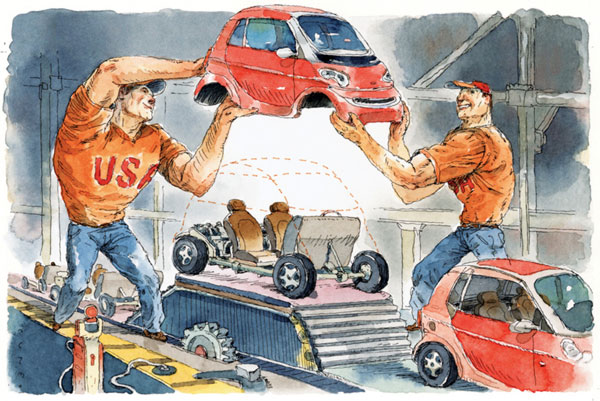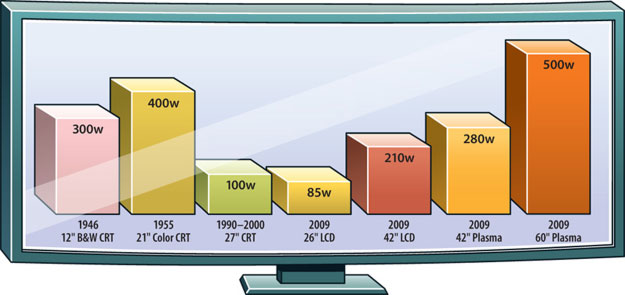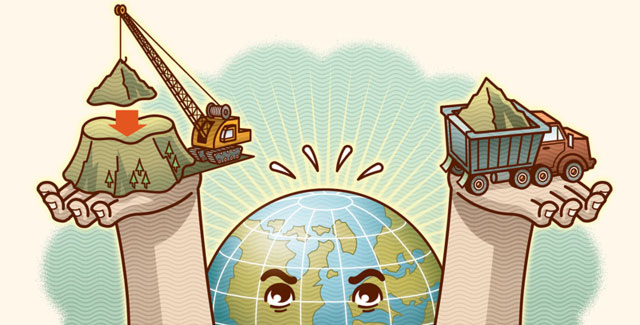sierraclub.org - sierra magazine - march/april 2009 - grapple


Grapple
Poor dumb Detroit might go back to SUVs unless Washington makes efficiency profitable

Before last September's economic collapse, Detroit's Big Three had already begun the costly process of retooling for a carbon-constrained future. In Avon Lake, Ohio, Ford was converting a plant that previously pumped out big Econoline vans to make the smaller, higher-mpg Transit Connect model popular in Europe. Forty miles east in Lordstown, General Motors was spending $317 million to shift assembly lines from producing Chevy Cobalts to cranking out the new, relatively fuel-efficient Cruze.
Those efforts went into a deep freeze as the financial crisis worsened. Meanwhile, the decline in gas prices raised the prospect that instead of going small and green, Detroit might simply resurrect its love affair with the SUV.
But given sufficient will and capital, Detroit could build and profitably sell zippy, fuel-efficient cars. It already does--in Europe, with models like the Ford Fiesta. The primary reason is higher gas taxes. On average, taxes account for 60 percent of the European pump price and as much as 75 percent in Britain. Years of sales data show that consumer willingness to buy fuel sippers closely tracks the price of gas. This has led numerous economists--including former labor secretary Robert Reich and Harvard's Robert Lawrence--to propose that the surest way to get Detroit to produce fuel-efficient vehicles is through some form of gas or carbon tax.
Raising U.S. gas taxes, however, is seen as a political impossibility, especially during a recession. Instead, Reich suggests making automakers pay for their cars' CO2 emissions through a cap-and-trade system. "This would give automakers a powerful incentive to make more fuel-efficient cars and price them far more attractively than the guzzlers, thereby attracting consumers," he writes on his blog. Another possibility is a revenue-neutral "gas guzzler/gas sipper" fee: Hummer buyers would pay it, and Chevy Volt purchasers would get a price break.
Lee Schipper, a senior scientist at UC Berkeley's Transportation Center, agrees that getting market incentives right is essential. "If Obama really wants to make a difference," he says, "he's going to have to change how Americans think about the cost of driving." --Andrew Leonard
Whale Whispers
When searching for whales in the frigid Beaufort Sea, Inupiat hunters listen for vibrations from the whales' songs through the oars of their tiny skiffs. When companies hunt for oil in those same Alaskan waters, they bring in noisy drill ships, icebreakers, and airplanes. This disrupts the whales' migration and feeding, argue the Inupiat, not to mention their own traditional subsistence lifestyle.
Last November, responding to a lawsuit filed by the Inupiat and the Sierra Club, among others, a federal appeals court halted plans by Royal Dutch Shell to drill up to 12 exploratory offshore oil wells in the Beaufort Sea. "It's a rebuke of the Bush administration's rush to open up the Arctic to oil and gas development," says Erik Grafe of Earthjustice, which represented some of the plaintiffs. It's now left to the Obama administration, he says, to "look at the impacts and conclude that it's not a good idea to go forward." --Dashka Slater
Sport Utility Televisions

We usually think of major appliances as being found in the kitchen, but there's a big bruiser in your living room (and, on average, 1.4 other places). A 50-inch plasma television can pull down more power than a modern refrigerator--and that's not counting all those connected TiVos and Wiis.
Television power consumption has seen little progress through the years. True, the picture is better and the screen is bigger, but the set your grandparents watched The Howdy Doody Show on probably didn't use much more energy than your new flat screen.
Some rules of thumb: Size matters more than technology--bigger screens use more energy. On a watt-per-square-inch basis, LCDs are better than plasma. (Europe is considering banning the largest plasma models.) Best of all are rear-projection microdisplay units. To save energy, turn off "quick start," turn down an LCD's backlight, and use the power-saver mode. Or unplug the darn thing and take a hike.
--Paul Rauber
The price of bagged spinach
That bag of prewashed salad in the supermarket may be convenient for you, but it's becoming less so for wild critters. After E. coli O157:H7 from bagged spinach killed three people and sickened nearly 200 in 2006, some producers of bagged leafy greens, among them Dole and the Chiquita subsidiary Fresh Express, developed proprietary standards known as "supermetrics" that require farmers to keep their fields totally free of wildlife.
In California's Salinas Valley, the source of 80 percent of the nation's lettuce, the result has been an all-out assault on the natural world. Nearly 90 percent of farmers there are clearing trees, plants, and brush; leaving poison bait for birds, squirrels, and mice; draining waterways or dousing them with frog-killing copper sulfate; and erecting eight-foot-high fences to keep out deer."
Farmers don't want to be doing this," explains Diana Stuart, an agricultural management graduate student at the University of California at Santa Cruz. "But the market is controlled by a handful of powerful companies, and they're helpless to resist."
Mike Burness, Fresh Express's vice president for global quality and food safety, insists that the company doesn't require vegetation removal--it simply asks farmers not to grow near vegetation. "If a food-safety concern exists regarding a specific vegetative area, we would ask the grower to grow elsewhere in the field, or move to a different field altogether," he says.
Such rules may be counterproductive. Less than one percent of wildlife carries E. coli, but up to 50 percent of cows do, and denuded soil allows dust from tainted manure to blow onto cropland. "Relatively small grass buffers can filter 99 percent of pathogens," says U.S. Department of Agriculture resource conservationist Danny Marquis.
Stuart hopes consumers can make the difference: "Do people know when they buy bagged salad, frogs are being poisoned in their ponds?" --D.S.
Time to find a new place to dump the garbage
For a long time, the system worked pretty well. U.S. consumers did what we do best--consume. The resulting refuse--paper, plastic, glass, aluminum, and more--would be shipped to China to be turned into new products and packaging for the U.S. market, and the whole cycle would begin again.
But then the bottom dropped out of both the economy and the price of oil. As production plummeted in the developing world, so did the demand for materials. Low oil prices meant that recycled plastic lost its price advantage over virgin plastic.
One of the chief selling points of recycled commodities--their energy cost savings--disappeared. "The market has pretty much tanked," says Chaz Miller, director of state programs for the National Solid Wastes Management Association.
Last November, prices for recyclable commodities dropped, sometimes by more than 80 percent. Mixed paper, which sold for $105 a ton in October, was selling for $20 a ton by December. The price for newspaper, which had commanded $200 a ton, plunged 90 percent, and cardboard fell by two-thirds. Plastic you can't even give away. Unable to find buyers for low-value materials, recyclers are either warehousing them or, ironically, sending them to the landfill. "You can't pay for storage forever," Miller says. "And some materials--paper and plastics--you have to keep out of direct sunlight. Sooner or later you're going to run into fire code issues. It's a matter of space."
The problem is compounded by the fact that in the 11 states where consumers pay a deposit on beverage bottles and cans, returns are up as much as 10 percent thanks to an economy that has people scrounging under sofa cushions for grocery money. And while recycling rates in the United States are lower than they could be--half the nation still has no curbside pickup--we are the world's largest paper recycler, collecting 43.2 million metric tons per year.
Even though the glut of recyclables is bad news in the short term, recycling advocates try to see it as an opportunity. At present the United States relies on foreign markets to purchase and re-cycle its garbage. What would happen if we reused our refuse here at home as part of that new green economy we keep hearing about?
"It's a huge opportunity domestically," says Conrad MacKerron, who's a program director at the corporate-responsibility nonprofit As You Sow. "There's been a lot of whining [from U.S. manufacturers] that they're being outbid by countries that until recently had a real thirst for our paper, plastic, and metals. Why not go in now and lock in better rates?"
As You Sow recently evaluated the recycling habits of the nation's major beverage companies. Most are far better at producing garbage than they are at reusing it. Of the 200 billion beverage containers sold in the United States each year, less than one-third are recycled. And while most aluminum cans contain 40 percent recycled material, the majority of plastic PET (polyethylene terephthalate) bottles are constructed entirely from virgin resin. Coca-Cola leads the beverage industry with 65 percent recycled content in its aluminum cans, and Pepsi wins the eco-bottle pageant by using 10 percent recycled PET.
Coca-Cola is now building a new PET-bottle recycling factory in South Carolina and has pledged to recover 50 percent of its plastic bottles and cans by 2015. Even so, the U.S. market for recyclables continues to shrink. A sixth of our egg cartons, shopping lists, and newspapers still goes to China, but that number is unlikely to increase anytime soon. Nor can U.S. paper mills take up the slack, given that they're closing at a furious rate. "I'd love to see more use of recycled materials in this country," Miller says. "But the reality is, we don't have the same manufacturing sector that we used to." --D.S.
Quick thinking before we slowly fry
MAN WITH A PLAN Leading the nation in the fight against climate change, the California Air Resources Board has approved a 122-page plan for bringing the state's greenhouse-gas emissions down to 1990 levels by 2020, a 15 percent reduction. The plan requires the state to get a third of its electricity from renewable sources, mandates buildings that are more energy efficient, and launches a cap-and-trade program that will cover 85 percent of California's greenhouse-gas-emitting industries. Governor Arnold Schwarzenegger (R) rebuffed criticism from his own party, arguing the plan will also create jobs: "Green tech is one of the few bright spots out there."
ANYWHERE THE WIND BLOWS If you're tired of waiting for your utility company to switch to wind power, why not start your own wind farm? For about $20,000, you can install a home wind turbine. Seventeen states are already supplying rebates or other financial incentives to help you do so. Make sure to check wind maps in your area first.
HIGH-FLYING HYPERMILERS Pilots are coasting into San Francisco International Airport as part of a fuel-saving initiative from Boeing, NASA, the federal Aviation Administration, and airlines like United and Air New Zealand. The Advanced Continuous Descent Approach uses satellite information and the plane's computer to calculate the most direct descent path; on a transpacific flight, this can save 1,564 gallons of fuel and 32,656 pounds of carbon emissions. Desperate to trim fuel costs, airlines are also seeking fuel alternatives: Last December, Air New Zealand tested a biofuel made from jatropha, a Central American succulent, and Continental tried an algae-jatropha blend in January.
—D.S.

ON THE ONE HAND ...
Bank of America will no longer finance coal companies that extract more than half their product by blowing the tops off mountains. B of A currently bankrolls eight coal-mining operators that practice mountaintop removal, which has flattened more than 800 square miles of Appalachian peaks and contaminated much of the region's drinking water. The decision came after years of pressure from local and national environmental groups and a Natural Resources Defense Council-sponsored flyover allowing bankers to see the devastation firsthand.
ON THE OTHER ...
Just before PresidenT George W. Bush left office, his administration made it easier for coal companies to decapitate mountains. A new EPA rule lifted an (indifferently enforced) ban on dumping mining waste into streams, thereby giving coal operators free rein to chuck the dirt, rock, and sludge that used to be mountain summits into adjacent valleys. This method of mining has already buried some 1,200 miles of Appalachian streams and dries up an estimated 100 drinking wells each year. —D.S.
Illustrations, from top: John Cuneo, Peter and Maria Hoey (2); used with permission.